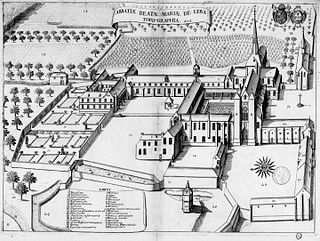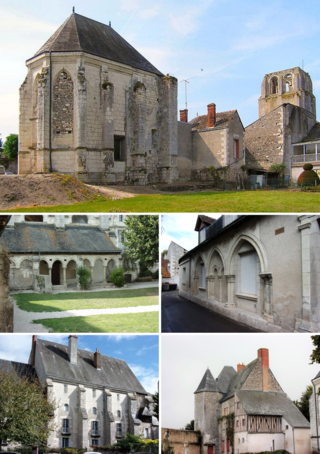
The Royal Abbey of Our Lady of Fontevraud or Fontevrault was a monastery in the village of Fontevraud-l'Abbaye, near Chinon, in the former French duchy of Anjou. It was founded in 1101 by the itinerant preacher Robert of Arbrissel. The foundation flourished and became the center of a new monastic Order, the Order of Fontevraud. This order was composed of double monasteries, in which the community consisted of both men and women — in separate quarters of the abbey — all of whom were subject to the authority of the Abbess of Fontevraud. The Abbey of Fontevraud itself consisted of four separate communities, all managed by the same abbess.

The Abbey of Saint-Étienne, also known as Abbaye aux Hommes by contrast with the Abbaye aux Dames, is a former Benedictine monastery in the French city of Caen, Normandy, dedicated to Saint Stephen. It was founded in 1063 by William the Conqueror and is one of the most important Romanesque buildings in Normandy.

Les Préaux is a commune in the Eure department and Normandy region of France.

Vaux-de-Cernay Abbey was a Cistercian monastery in northern France (Île-de-France), situated in Cernay-la-Ville, in the Diocese of Versailles, Yvelines.

Bonnevaux Abbey is a former Cistercian monastery located in Lieudieu near Villeneuve-de-Marc in the Isère department of France, situated within the Dauphiné region. It is positioned 25 kilometres east of Vienne approximately 6 kilometres south-east of Saint-Jean-de-Bournay, on the northern perimeter of the Forêt de Bonnevaux.

Arthur Le Moyne de La Borderie, was a Breton historian, regarded as a father of Brittany's historiography.

Redon Abbey, or Abbey of Saint-Sauveur, Redon, in Redon in the present Ille-et-Vilaine, Brittany, France, is a former Benedictine abbey founded in 832 by Saint Conwoïon, at the point where the Oust flows into the Vilaine, on the border between Neustria and Brittany.

Maubuisson Abbey is a Cistercian nunnery at Saint-Ouen-l'Aumône, in the Val-d'Oise department of France. It was founded in A.D. 1236 by Blanche of Castile, Queen of France, who may have been buried there in 1252. The site is now within the north-western suburbs of Paris. The surviving buildings are listed as a monument historique.

Signy Abbey was a Cistercian abbey located in Signy-l'Abbaye, Ardennes, France. It is located about 65 kilometres (40 mi) northeast of Reims and about 28 kilometres (17 mi) west of Charleville-Mézières on the edge of the Froidmont forest. It was founded on 25 March 1135, the feast day of the Annunciation. It was sold as national property in 1793 and completely demolished. Its library was burned.

The Abbey of Saint-Savin-en-Lavedan was a Benedictine abbey in the commune of Saint-Savin, Hautes-Pyrénées, France. It was one of the most important religious centres in the County of Bigorre. The Romanesque abbey church remains, in use since 1790 as a parish church. It has been listed since 1840 as a monument historique by the French Ministry of Culture.

The Abbey of Saint-Cybard was a Benedictine monastery located just outside the northern city walls of Angoulême.

The Abbey of St. John, Laon was a Benedictine monastery in Laon, France, from 1128 to 1766, which replaced a nunnery founded in 641. The prefecture of the department of Aisne now occupies the site.

Lyre Abbey was a monastery in Normandy, founded in 1046 at what is now the village of La Vieille-Lyre. From the mid-12th century it was a Benedictine house. It was abolished at the French Revolution and the abbey buildings mostly destroyed.

Préaux Abbey was a Benedictine monastery dedicated to Saint Peter at Les Préaux, in Normandy, France.

Fontenelles Abbey or Les Fontenelles Abbey was an Augustinian monastery in the former commune of Saint-André-d'Ornay, in the Vendée, France.

The Abbey of Saint-Martin de Savigny was a Benedictine monastery in the Archdiocese of Lyon. Nothing today survives of its buildings other than some stones in the Musée Lapidaire of Savigny-en-Lyonnais.

Dalon Abbey is a former Cistercian monastery in Sainte-Trie, Dordogne, southwestern France. It is listed as a Historic Monument.

Montivilliers Abbey is a former Benedictine nunnery, founded between 682 and 684 by Saint Philibert in the town of Montivilliers in Normandy, in the present department of Seine-Maritime, France. It was suppressed during the French Revolution, but many buildings, including the church, have survived.

Comercy Abbey or Saint-Paul de Cormery Abbey is a former Benedictine abbey located on the territory of the commune of Cormery in the French department of Indre-et-Loire in the Centre-Val de Loire region.


















